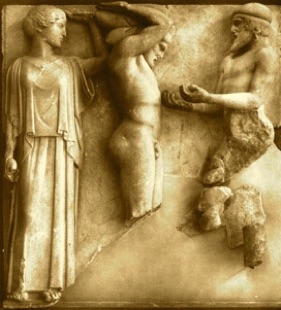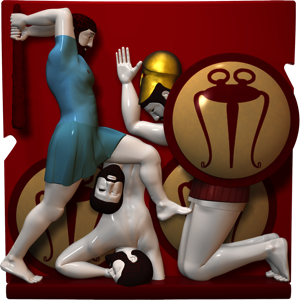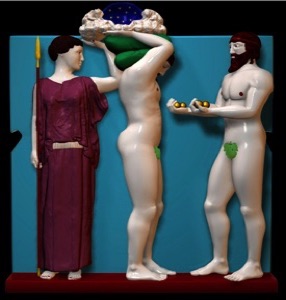



The two interrelated 2450-year-old sculptures directly over the sacred east entrance to the temple of Zeus at Olympia (restored by computer by Holmes Bryant) summarize the boast of Zeus-religion. They explain simply and graphically how Nimrod/Herakles, with the help of Naamah/Athena, overcame the Yahweh-believing sons of Noah, and restored the way of Cain after the Flood.
The one to the left depicts Nimrod/Herakles killing the triple-bodied warrior, Geryon. There were no triple-bodied warriors in ancient days, any more than there are triple-bodied warriors today. And yet we see Nimrod/Herakles, having beaten two of Geryon’s bodies to death, about to mercilessly club the third.
What could a triple-bodied man signify? Noah had three sons, Shem, Ham, and Japheth. Nimrod’s rebellion reached its height during the time of their rule. By killing the triple-bodied Geryon, Nimrod/Herakles is figuratively overcoming the spiritual authority of Noah’s three sons. After their deaths, Nimrod/Herakles ruled unchallenged.
The adjacent sculpture tells us whose authority replaced that of Noah’s sons. Athena’s support, combined with great efforts of his own, has enabled Herakles to push away the heavens, and with them, the God of the heavens. Herakles has thus gained access to the golden apples from the serpent’s tree in the Garden of the Hesperides. His great-grandfather, Lamech/Atlas, the last king of the Cainite world before the Flood, offers him the apples, the forbidden fruit once offered by the ancient serpent to the first couple, Adam/Zeus and Eve/Hera in paradise.
Thus, these two sculptures commemorate the successful rebellion of Nimrod/Herakles inspired by Naamah/Athena, celebrate an end to the interference of Noah’s “oppressive” God with post-Flood humanity, restore the ruling family of the line of Cain, and chronicle mankind’s return to the way of Cain and the “enlightenment” of the Genesis serpent. See also Return to the Garden